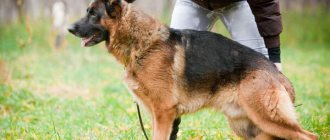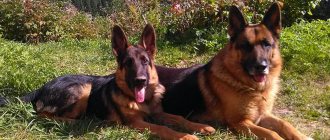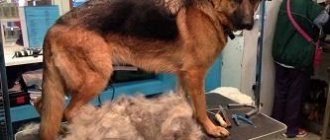Correct position when feeding
The shepherd dog has grown significantly in one month and stands confidently on all 4 legs - it’s time to get used to eating from a bowl located on a stand.
It is important to teach this position while eating from an early age so that the baby does not develop the habit of throwing food out of the bowl and picking up pieces from the floor - one, and his exterior is correctly formed - two.
It will be difficult, but possible, to wean him off from picking up pieces, and it will be impossible to correct the hunchback, high hindquarters and weak front pasterns.
The bowl should be at the height of a one-month-old puppy’s chest so that he can only put his muzzle in there. Place a rug made of thick fabric under the shepherd's paws so that the baby's paws do not move apart and the rug itself does not slide on the floor surface.
Special bowl for feeding shepherds
As the German Shepherd grows, the height to which the bowl is raised should also “grow”.
How to properly maintain an apartment?
If it has been decided to keep a German Shepherd in an apartment, then you need to arrange a cozy place for it in the living room (you cannot place the dog in the bathroom, kitchen, hallway or balcony) away from drafts and heat sources.
NOTE!
Shepherds shed a lot, so it is important to regularly clean the apartment, especially if children, pensioners, or allergy sufferers live there.
What and how to feed a 1 month old German Shepherd puppy
A one-month-old German Shepherd puppy is already familiar with a variety of foods and should eat 1 glass of food per day - this is true, but you still need to focus not so much on the total volume as on the general condition of the animal.
The feeding rate for each shepherd dog is individual, and it can only be established experimentally.
The food should be eaten “in a sneaky manner”, and the satiated baby should calmly move away from the bowl to his place and, most likely, go to bed. If the eater is bloated after breakfast or lunch, give him a little diluted milk with magnesium, and it is better to reduce the portion next time.
As they say: “After a hearty lunch, you should sleep”
The poor fellow who has not eaten enough will spend a long time “scraping” the bowl with his tongue, asking for more with his entire appearance. However, at this moment there is no need to add anything to the bowl, so as not to accustom the dog to handouts and begging. The portion will be increased at the next feeding.
Diet for puppies from 2 months to a year
The fundamental difference in feeding a German Shepherd puppy from other breeds is strict calcium control . Its excess can lead to pathology in development. Giving puppies vitamins with calcium is not recommended.
A reliable guideline for determining proper nutrition is the weight of a furry baby in the 6th month of life. It should not exceed 60% of the weight of an adult . If the puppy weighs more, then you need to reduce the amount of high-calorie food in the diet.
Menu composition: gradual decrease in the proportion of milk, increase in the amount of meat, vegetables and porridge. You can combine natural products with dry food (do not mix at the same time!). With this approach, in the morning the puppies are given food that is specially designed for puppies (can be soaked in water), and in the afternoon - natural products.
Tip : when combining dry and natural food, single servings are halved! Preference should be given to super premium food, the quality of which has been confirmed by veterinarians.
Portions:
- From 2 to 3 months – 5 times a day, 3-4 partial glasses of food per day;
- From 4 to 6 months – 4 times a day, 1 liter of food;
- From 6 to 12 months - 3 times a day, 1.5 liters of food.
Eating whims or developmental transition period
If your baby willingly eats one type of food and refuses another, do not indulge such whims. Otherwise, you will have to feed your German Shepherd only what he wants. As a rule, it will be unhealthy or even dangerous food.
Reasons for refusal
On the 25-30th day of development, taste reactions in shepherd dogs become more acute. If before this period the puppy relied more on smell, now taste complements the range of sensations.
During this period, it is especially important that the food offered is neither hot nor cold, nor bitter, nor spicy, etc. Otherwise, the shepherd will associate the smell of this type of food with an unpleasant sensation in the mouth and refuse to eat THIS for a long time.
The second reason is that after this meal the baby felt sick, and he associated the malaise with the taste and smell of this food.
The third reason is that the puppy is not hungry by the time of feeding.
He would happily chew some “yummy” food, but you will do the right thing and don’t offer any “yummy” food instead of real food, so as not to teach him to be capricious and pick at food.
You can’t force feed, but you also don’t need to change food “at the request of the workers.”
If your pet refuses to eat, do not follow his lead.
In 10 minutes. After discarding what is in the bowl, put its contents in the refrigerator. At the next feeding time, you will reheat and serve the same food again.
From one month onwards, you can skip one feeding without harming the health of the growing dog.
By the way, you shouldn’t worry that your puppy’s menu is too monotonous: your pet can do just fine without culinary delights, which can lead to gastritis. Gastritis in German shepherds whose feeding regimen was not followed is a frequent phenomenon, its development is asymptomatic, the course is severe, even fatal.
Your dog only needs systematic, proper feeding at regular intervals!
A one-month-old shepherd dog is fed 6 times, timing the time with the general daily routine in the house. For example, the first portion is at 6 am, and the last at 21.00: 6.00 – 9.00 – 12.00 – 15.00 – 18.00 – 21.00. Small deviations in one direction or another are allowed for no more than half an hour.
Feeding puppies at home
Usually, by 6 weeks, the bitch’s lactation weakens and the milk itself is no longer so rich as to be a complete food for her children. You will need to introduce several new products to your puppy's menu.
Blood
It’s good if you have the opportunity to buy blood obtained from the slaughter of farm animals - it contains more than 30% complete, easily digestible proteins, has bactericidal properties (the first 4 hours after slaughter), and prevents the occurrence of iron deficiency anemia. Pork blood is given only in the form of boiled fibrin (clotted blood).
When feeding with blood, salt is excluded from the diet!
Blood can be preserved in reserve, like regular meat, but the value of such a product decreases significantly.
Meat
From 4 weeks, you need to give boiled pieces of chicken or rabbit, cut large enough so that the puppy has to work hard to chew them. Very useful for the development of jaws and neck muscles!
Fish
When feeding fish to a puppy at the age of 1 month, it is necessary to strictly follow the norms.
At this age (1-1.5 months), you need to introduce sea fish into the diet. The ideal option is the salmon family (salmon, mykiss, whale, chinook salmon, sockeye salmon, coho salmon, whitefish, pink salmon, whitefish, nelma). For now, the fish is only boiled, without bones, and only once a week.
If a little “German” eats fish more often, then B vitamins are destroyed in his body, which causes indigestion and growth retardation. But without fish, the body does not receive the enzymes that bind iron, the deficiency of which leads to a decrease in the immune system of the developing German Shepherd. A serving of fish should be one and a half times larger than a serving of meat.
Fat and oil
At 1 month of age, additional fats and oils are introduced into the puppy’s diet. Young German Shepherds should receive 2.6 g of fat per 1 kg of weight per day. This means that at 1 month the baby will need 10-15 g of animal fat (butter) or vegetable fat. Butter contains carotene, tocopherol, choline, phosphatites, vitamins A and D-2.
Vegetables contain polyunsaturated fatty acids that promote metabolism and tonic the walls of blood vessels, and vitamin E, which is not found in animal products.
With a lack of fat, skin peeling, dandruff, hair depigmentation, hypovitaminosis and developmental delay are observed. The shepherd dog should eat fats on a rotating schedule: today – vegetable, tomorrow – animal.
Potatoes, butter, meat, fish, vegetables - all this must be included in the puppy’s diet
Bones
At one and a half months old, German Shepherd puppies are given large joint sugar bones in their raw form.
Potatoes and tomato paste
At 1.5 months, tomato paste and raw potatoes are added to the diet. High-quality tomato paste contains ascorbic acid, tocopherol, lycopene and beta-carotene - antioxidants that reduce the risk of developing complex diseases of internal organs. How many times should I give tomato puree? The weekly dose for 6 weeks is ½ tsp, you can give the whole portion at once.
Raw potatoes, which in addition to starch and a lot of useful substances, also contain potassium, which is necessary for the proper functioning of the heart, is necessary for water-fat metabolism and healthy kidney function. 100 g of grated raw potatoes contains 2 times more potassium than meat!
Norm – 1 tbsp. l. freshly grated potatoes with juice and pulp.
Vegetables
Don't forget to include vegetables in your puppy's diet.
Add zucchini, turnips, beets, and pumpkin. While the baby receives them in stewed form, mixed into porridge with bone broth. Two-month-old German Shepherd babies eat almost all vegetables and fruits raw, except pumpkin and beets.
Top dressing
At 4-6 weeks, mineral supplementation is introduced, which you can do yourself:
- bone meal – 1 cup;
- phytin – 40 crushed tablets;
- glycerophosphate – 40 crushed tablets;
- calcium lactate – 20 crushed tablets;
- calcium gluconate – 20 crushed tablets;
- activated carbon – 20 crushed tablets;
- brewer's yeast with sulfur or selenium – 450 g;
- white school chalk - 15 g;
- salt – 5 g.
Feeding is given along with porridge, 0.5 tsp. daily for up to 2 months. From 2 months the same dose is given three times a day.
How to feed?
The German Shepherd is a fairly large dog that requires large amounts of food daily. Each owner chooses for himself how and what to feed his pet, but it is important to follow a number of rules to maintain the health of the pet.
Dry food
With dry food, everything is simple - it does not need to be prepared, it is stored for a long time and has the necessary set of substances for the development of a dog. You should not save on dry food and buy low-quality food - this will not end well, since the body of purebred dogs is more sensitive to low-quality food.
You need to feed your dog dry food at approximately the same time in limited portions, and fresh, clean water should always be available.
Natural food
With natural food, everything is more complicated - it needs to be prepared separately for the animal (it is strictly forbidden to give the same thing that the owner eats) and only from those products that are allowed for representatives of this breed.
The proper diet for an adult dog consists of:
- 30% meat . The dog gets the necessary protein from meat. You can give it raw, cut into small pieces or lightly boiled with boiling water. Chicken, lean pork, and beef are excellent. Meat can be mixed with porridge;
- offal . All of them are given raw, except for the liver, since there may be helminths there; it is first boiled;
- cereals _ Shepherd dogs can eat any porridge, including milk porridge, except for semolina, which is poorly excreted from the animal’s body;
- dairy . Cottage cheese, kefir and yogurt should occupy a significant place in the animal’s diet;
- vegetables and fruits . Shepherd dogs happily eat zucchini, pumpkin, beets, cabbage, and greens. You can give them cut into pieces or grated. Fruits - as a treat in small portions with the addition of a small amount of butter or sour cream for better absorption.
Feeding with natural food outperforms dry food in terms of variety, but loses in terms of time.
IMPORTANT!
Whatever the dog’s diet, the animal must have clean water around the clock. It needs to be changed daily.
What to avoid in the diet of a month old shepherd dog
Here the rules of care and feeding remain unchanged:
- low-quality products;
- factory products with various additives;
- food with spices;
- overfeeding with vitamins;
- hot or very cold food;
- boiled potatoes;
- tubular bones;
- sweets, sausages, smoked meats;
- sorrel;
- overfeeding or underfeeding;
- "treats" from you and your friends.
Drying can only be used at one feeding per day
Attention! At such a young age, you cannot feed your baby only dry food, no matter what super class it is.
It may contain components that cause severe allergies. “Drying” only as a substitute for the 1st of 6 daily feedings.











